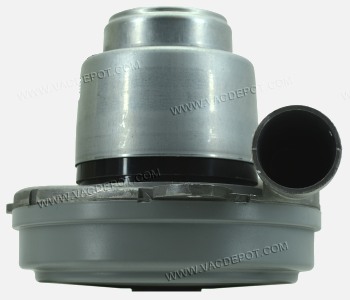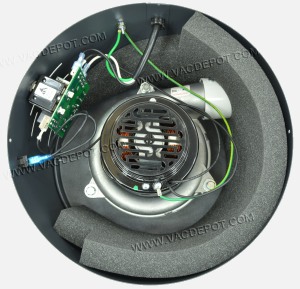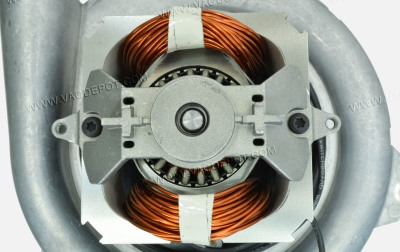 It is the middle of summer and in south Texas it is hot! The temperature outside does not impact the operation of a homes central vacuum system, but cooling is very important. Cooling has a big impact on how well vacuum motors perform and how long they will last. Two motor designs are used most often in central vacuum systems and the primary difference of them is how they are cooled. The traditional central vacuum motor design is called bypass, and employs two fan systems – one to work and one to cool. The working air bypasses the motor, hence the name, and the cooling fan uses other (cooler) air to keep the motor cool. The other motor system is called thru-flow, which uses one fan system to both work and cool the motor hopefully after the airflow has been filtered. Thru-flow motors use the working air to flow over the motor, hence the name, and carry away the built up heat. There can be other differences between the two designs but cooling is most important.
It is the middle of summer and in south Texas it is hot! The temperature outside does not impact the operation of a homes central vacuum system, but cooling is very important. Cooling has a big impact on how well vacuum motors perform and how long they will last. Two motor designs are used most often in central vacuum systems and the primary difference of them is how they are cooled. The traditional central vacuum motor design is called bypass, and employs two fan systems – one to work and one to cool. The working air bypasses the motor, hence the name, and the cooling fan uses other (cooler) air to keep the motor cool. The other motor system is called thru-flow, which uses one fan system to both work and cool the motor hopefully after the airflow has been filtered. Thru-flow motors use the working air to flow over the motor, hence the name, and carry away the built up heat. There can be other differences between the two designs but cooling is most important.
Bypass motors are always cooling themselves at the same level anytime they are running and are not affected by other parts in the vacuum system, maintenance requirements or the vacuum user. On the other hand a thru-flow motors cooling efficiency is affected by nearly every part of a complete vacuum cleaning system and also by how the vacuum system is used and maintained. Thru-flow cooling is affected by filter performance, debris particle size, length of PVC tubing, degree & number of elbows in the tube system and the composition, design and length of the vacuum hose, and perhaps most importantly the orifice of the cleaning tool being used.
 Small changes in any of these factors reduces the cooling performance of thru-flow motors which in turn effects the motors efficiency. The very design of thru-flow motors made them undesirable in central vacuum systems for the first 50 years of central vacuum mass production. While thru-flow motors can be made to look comparable on paper, in the real world they fail to perform near the same level as their bypass counterparts. Many thru-flow motors also suffer from a much shorter life span, a trait they carry over from their portable (and disposable) vacuum history.
Small changes in any of these factors reduces the cooling performance of thru-flow motors which in turn effects the motors efficiency. The very design of thru-flow motors made them undesirable in central vacuum systems for the first 50 years of central vacuum mass production. While thru-flow motors can be made to look comparable on paper, in the real world they fail to perform near the same level as their bypass counterparts. Many thru-flow motors also suffer from a much shorter life span, a trait they carry over from their portable (and disposable) vacuum history.
Central vacuum filtration and collection systems are diverse, and it seems that everyone has their own preference of style. While you can make an argument for using one of the many styles of collection and filtration in central vacuums there is simply no debate in central vacuum motor design. The bypass motor design is far superior to the thru-flow motor in every measure but one. So why is this even an issue? Unfortunately more and more manufacturers are using the lesser quality design thru-flow motor systems. What was a fraction of a percent just twenty years ago is now more than 40% of the market. And even more troubling is that many manufacturers no longer declare what type of motor system they are using. Can you imagine looking at a new car on the dealers lot with a lock on the hood, and when you ask the sales guy What gives with the lock? What’s under the hood? And the sale guy responds “could be a International 6.0L V8 diesel engine or could be a eco-somthing 1.4L smarty turbo-4. Either way, both can get up to 55mph so it does not matter”. Obviously it does matter which is exactly why some manufacturers do not disclose the motor type in their CVS power units.
 Why do they use the lesser design motor at all? At one time [a particular manufacturer] tried to promote the change as “better for the environment”. Back then the thru-flow motors were only manufactured in smaller amperage configurations and despite being severely under powered they did use less electricity. What they did not disclose was the cost savings was enough to allow you to run your microwave to heat a cup of coffee once per month with your wind fall of savings.
Why do they use the lesser design motor at all? At one time [a particular manufacturer] tried to promote the change as “better for the environment”. Back then the thru-flow motors were only manufactured in smaller amperage configurations and despite being severely under powered they did use less electricity. What they did not disclose was the cost savings was enough to allow you to run your microwave to heat a cup of coffee once per month with your wind fall of savings.
Manufacturers should have instead advised customers to keep their pennies of savings to buy replacement thru-flow motors which would only last about half the average life span of bypass motors. Surprisingly companies did not make the change to save consumers money, it was to make more themselves (I can see the shock on your face). What is that one area where thru-flow motors are better than bypass motors? Cost. Thru-flow motors are cheaper and more plentiful. What was once the most expensive part of the central vacuum can now be as cheaply produced as every other part in the vacuum. All that it required was some marketing magic to convenience consumers that less is more.
Stop the toss & replace manufacturing culture from taking over built-in vacuums. Do your part next time you purchase a central vacuum power unit. Buy a real central vacuum with a real bypass motor. All Aspria brand central vacuum power units use only Ametek Lamb Bypass motor systems, of course.